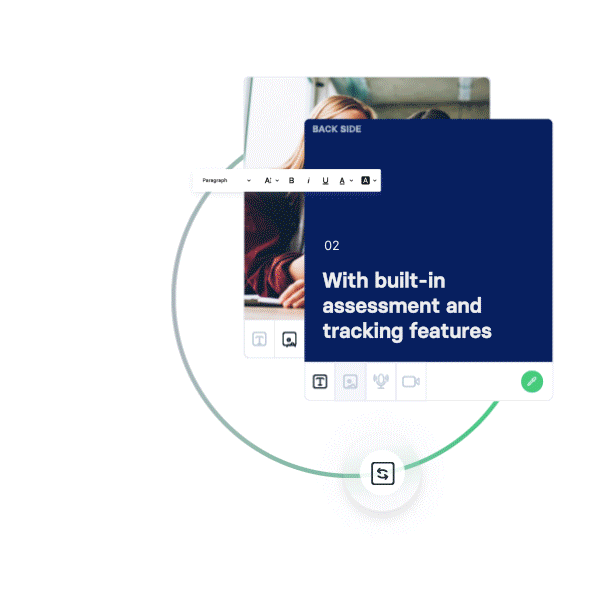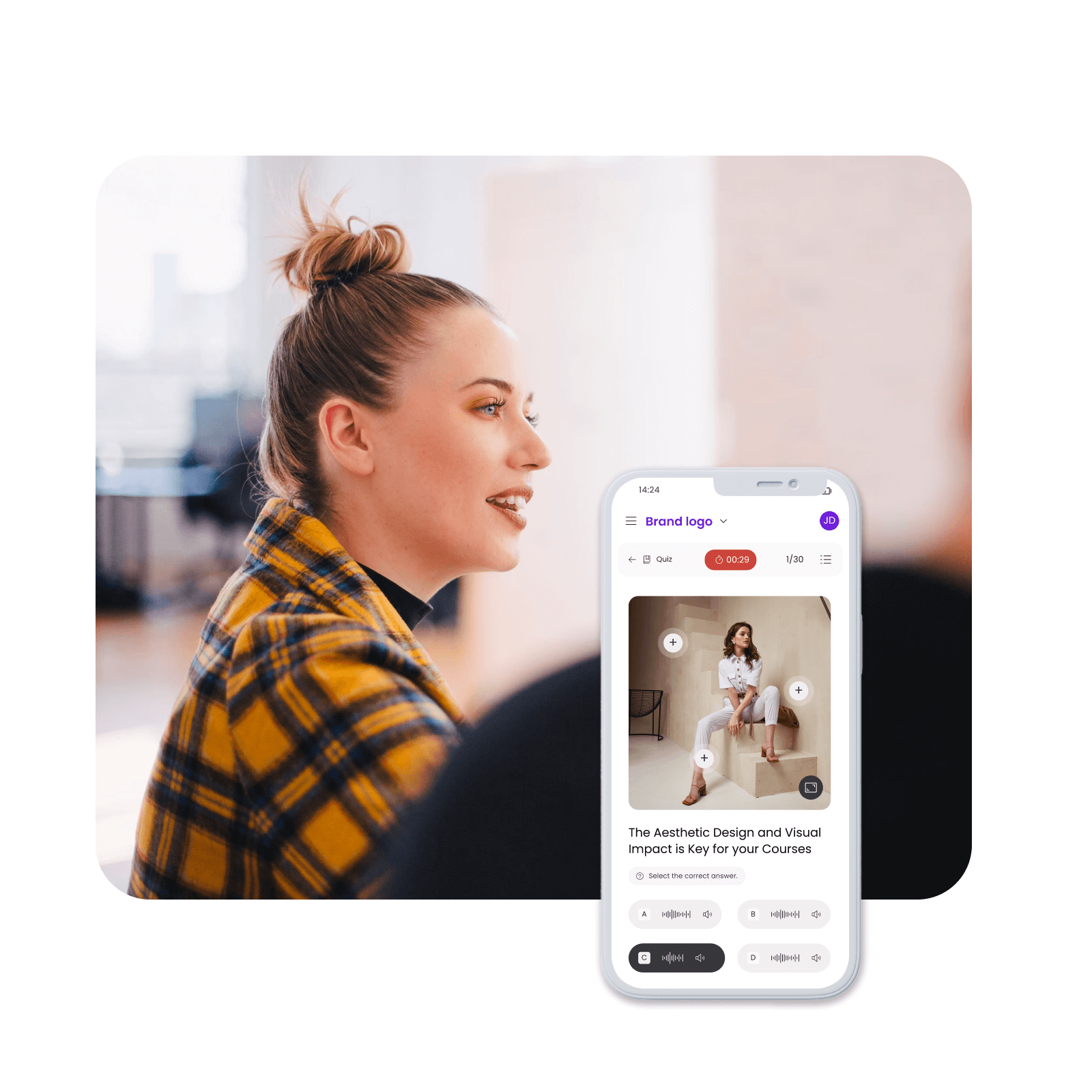Succeed your Online Training for retail
6 Tips to succeed your Online Training for retail
Designing and crafting engaging eLearning courses for the retail industry can indeed be a smooth and efficient operation, provided that certain rules and processes are respected.
The key to success lies in understanding the unique requirements of retail training and implementing a specific workflow tailored to meet these needs. Online training for retail must be designed to reach learners wherever they are, catering to a diverse range of learning styles.
This means the content needs to be rich and varied, incorporating visual elements to captivate the eye, auditory components to engage the ear, and kinesthetic activities to involve learners physically.
By combining these elements, eLearning courses can provide a comprehensive learning experience that is both engaging and effective, ensuring that retail employees are well-equipped with the knowledge and skills they need to excel in their roles.
What are the benefits of training for retail employees?
Retail training programs are essential for equipping employees with the skills and knowledge necessary to succeed in the fast-paced and dynamic retail environment.
These programs offer a multitude of benefits, not only enhancing the overall customer experience but also boosting employee morale and productivity. By investing in retail training, businesses can ensure their staff are well-versed in product knowledge, customer service excellence, and sales techniques, leading to improved customer satisfaction and loyalty.
Well-trained employees are more confident and efficient in their roles, contributing to the smooth operation of the retail business.
This introduction aims to explore the myriad advantages of training for retail employees, highlighting how such initiatives can significantly impact both individual performance and the organization's bottom line.
1. Design a clear Onboarding
Designing a clear onboarding process for staff in the retail industry is crucial for several reasons.
It sets the tone for an employee's experience within the company, offering a structured introduction to the company culture, expectations, and their role within the organization.
A well-crafted onboarding program accelerates the learning curve, allowing new hires to become productive members of the team more quickly. This is especially important in retail, where the quality of customer service directly influences sales and customer loyalty.
Effective onboarding can significantly reduce turnover rates by ensuring employees feel valued, supported, and engaged from the outset. In essence, a clear onboarding process is not just about making a good first impression; it's about laying the foundation for sustained success and growth within the fast-moving retail sector.
2. Aid jobs or real work examples
One of The primary mission of retail training is to develop practical aid jobs and present real-world challenges along with their solutions, effectively bridging the gap between theoretical knowledge and practical application.
This approach ensures that employees are not only well-versed in standard operating procedures but are also equipped to handle the dynamic and often unpredictable nature of retail work.
By simulating real-life scenarios, retail training empowers employees with the confidence and skills needed to address a range of situations, from customer service dilemmas to operational challenges.
This hands-on strategy enhances problem-solving abilities, encourages proactive thinking, and fosters a deeper understanding of the retail environment. Ultimately, the goal is to prepare employees for the realities of their roles, ensuring they can contribute effectively to the business’s success and maintain high levels of customer satisfaction.
3. Adopt multimedia Learning
Offering a rich multimedia experience to learners is paramount in capturing their attention and enhancing their learning journey.
By incorporating beautiful visuals, engaging audio, and detailed videos that provide a rich kinetic experience, educational content becomes much more immersive and memorable. Visual elements can simplify complex concepts, making them easier to understand, while audio components add depth, helping to maintain the learner’s interest over time.
Videos that combine both visual and auditory stimuli with interactive or kinetic elements enable learners to experience scenarios as if they were real, facilitating a deeper understanding and retention of knowledge.
This multifaceted approach caters to different learning styles, ensuring that all learners can benefit from the material in a way that best suits them.
A rich multimedia experience can simulate real-life situations that learners might face, providing them with the confidence and skills to apply their knowledge effectively in the real world.
This not only enhances the learning experience but also prepares learners for practical application, making education both engaging and valuable.
4. Benefits of Nano and Macro Learning
Adopting nano and micro-learning strategies for retail training is increasingly important in today's fast-paced retail environment.
These approaches break down complex information into small, manageable chunks, making learning more accessible and less overwhelming for employees.
Nano-learning involves very short learning segments, often just a few minutes long, perfect for conveying a single concept or procedure.
Micro-learning, while slightly longer, still focuses on delivering concise, specific knowledge. This method is particularly effective in retail, where time is often limited, and employees need to quickly acquire new skills or information.
By integrating nano and micro-learning, retailers can provide flexible, on-demand training that fits seamlessly into the busy schedules of their staff, ensuring that learning is ongoing and directly relevant to their immediate needs.
This approach not only improves knowledge retention but also enables employees to apply what they’ve learned more rapidly and effectively, enhancing performance and customer service on the shop floor.
5. Social and Peer to Peer Learning
Fostering a strong learning community through social and peer-to-peer learning opportunities is crucial in any educational setting, including retail training.
This approach leverages the collective knowledge and experiences of the group, encouraging learners to engage with one another, share insights, and solve problems collaboratively.
Social learning not only enhances the learning experience by making it more interactive and engaging but also helps to reinforce knowledge through discussion and practical application.
Peer-to-peer learning, where employees learn from the experiences and expertise of their colleagues, can be particularly effective in a retail context. It allows for the sharing of real-world examples and best practices, fostering a sense of camaraderie and support among team members.
By prioritizing social and peer-to-peer learning, retailers can create a dynamic and supportive learning environment that encourages continuous professional development and strengthens the overall skill set of their workforce.
6. Mobile Learning
Mobility is a crucial detail in online retail training, underscoring the importance of accessibility and flexibility in learning.
In today’s fast-moving retail landscape, the ability to learn on-the-go is not just an advantage; it’s a necessity.
Mobile-friendly training programs allow employees to access learning materials anytime, anywhere, enabling them to fit training into their busy schedules rather than the other way around. This level of accessibility ensures that learning can happen in moments that might otherwise be underutilized, such as during commutes or between sales sessions.
Mobility in training supports a more immediate application of knowledge, allowing employees to reference materials at the point of need, directly on the sales floor or when interacting with customers.
This instant access not only enhances learning efficiency but also significantly improves performance and customer service in real-time.
Incorporating mobility into online retail training aligns with the modern workforce's demands, offering a seamless, flexible learning experience that meets employees where they are.
Conclusion: The Learning Lab, Learning Platform for online retail training
The Learning Lab is an innovative learning platform specifically designed for online retail training, offering a comprehensive and interactive educational experience tailored to the needs of the retail industry.
Our Learning platform stands out by providing a rich repository of courses and materials that cover a wide range of topics, from customer service excellence and sales techniques to product knowledge and operational efficiency. What sets The Learning Lab apart is its user-friendly interface and adaptive learning technologies, which personalize the learning journey for each user, based on their progress, preferences, and performance.
The Learning Lab incorporates gamification, social learning, and real-world simulations, making learning not only effective but also engaging and enjoyable.
This approach ensures that retail employees are well-equipped with the skills and knowledge necessary to thrive in a competitive market, enhancing both their personal development and the overall customer experience.
The Learning Lab is more than just a training tool; it's a comprehensive learning ecosystem designed to empower retail professionals and drive business success.
Simplify Learning,
Elevate Design.
IMAGINE. CREATE. CRAFT. INNOVATE. LEARN.








